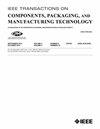Less Is More: Non-TIM Air-Cooled Ceramic Packaging for SiC Power Modules to Extend Thermal Performance and Mechanical Reliability Boundaries
IF 2.3
3区 工程技术
Q2 ENGINEERING, ELECTRICAL & ELECTRONIC
IEEE Transactions on Components, Packaging and Manufacturing Technology
Pub Date : 2024-12-09
DOI:10.1109/TCPMT.2024.3513944
引用次数: 0
Abstract
Power module packaging remains one of the constraints preventing silicon carbide (SiC) devices from realizing high power density and optimal reliability in converters. This article proposes a non-thermal interface material (TIM) air-cooled power module architecture, i.e., chip-on-heatsink, to enhance both thermal performance and structural reliability. The chip-on-heatsink packaging bonds conductive copper traces and an aluminum nitride (AlN) ceramic heatsink together without requiring TIM. This non-TIM packaging design streamlines the manufacturing process by eliminating certain steps, such as attaching the bottom copper layer on substrates and assembling heatsinks, since there are few layer stacks between chips and the heatsink. Two types of 1200 V, 36 A power modules are manufactured and experimentally compared. One utilizes the non-TIM structure integrated with少即是多:用于碳化硅功率模块的非 TIM 空气冷却陶瓷封装,扩展热性能和机械可靠性边界
功率模块封装仍然是阻碍碳化硅器件实现高功率密度和转换器最佳可靠性的制约因素之一。本文提出了一种非热界面材料(TIM)风冷电源模块架构,即芯片上的散热器,以提高热性能和结构可靠性。芯片上的散热器封装将导电铜迹和氮化铝(AlN)陶瓷散热器粘合在一起,而不需要TIM。这种非tim封装设计通过消除某些步骤简化了制造过程,例如在基板上连接底部铜层和组装散热器,因为芯片和散热器之间的层栈很少。制作了两种1200v、36a功率模块,并进行了实验比较。其中一种采用非tim结构,集成了50 × 38 × 24 × mm的铝陶瓷散热器,另一种采用标准的传统包装,配备了相同尺寸的6063铝合金散热器。在各种空气冷却和功率损耗条件下进行的测试显示,与传统模块相比,非tim电源模块的结对环境热阻始终降低约2%,这表明非tim封装的热性能得到了增强。此外,持续的性能测试证实了非tim电源模块封装在650 V直流链路2 kW下的适用性,使其成为电源转换器应用的可行选择。此外,采用电-热-机械有限元分析(FEA)模型和数字图像相关(DIC)测试来评估面内变形。结果表明,与传统结构相比,非tim封装的mosfet在定义路径上的最大应力显著降低了40.2%,表明该封装具有更好的可靠性。
本文章由计算机程序翻译,如有差异,请以英文原文为准。
求助全文
约1分钟内获得全文
求助全文
来源期刊

IEEE Transactions on Components, Packaging and Manufacturing Technology
ENGINEERING, MANUFACTURING-ENGINEERING, ELECTRICAL & ELECTRONIC
CiteScore
4.70
自引率
13.60%
发文量
203
审稿时长
3 months
期刊介绍:
IEEE Transactions on Components, Packaging, and Manufacturing Technology publishes research and application articles on modeling, design, building blocks, technical infrastructure, and analysis underpinning electronic, photonic and MEMS packaging, in addition to new developments in passive components, electrical contacts and connectors, thermal management, and device reliability; as well as the manufacture of electronics parts and assemblies, with broad coverage of design, factory modeling, assembly methods, quality, product robustness, and design-for-environment.
 求助内容:
求助内容: 应助结果提醒方式:
应助结果提醒方式:


